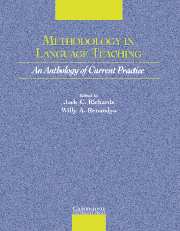Book contents
- Frontmatter
- Contents
- Acknowledgments
- Introduction
- Section I Approaches to Teaching
- Section 2 Lesson Planning and Classroom Management
- Section 3 Classroom Dynamics
- Section 4 Syllabus Design and Instructional Materials
- Section 5 Task and Project Work
- Section 6 Learning Strategies
- Section 7 Teaching Grammar
- Section 8 Teaching Pronunciation
- Section 9 Teaching Speaking
- Section 10 Teaching Listening
- Section 11 Teaching Vocabulary
- Section 12 Teaching Reading
- Section 13 Teaching Writing
- Chapter 29 Ten Steps in Planning a Writing Course and Training Teachers of Writing
- Chapter 30 The Writing Process and Process Writing
- Chapter 31 A Genre-Based Approach to Content Writing Instruction
- Chapter 32 Teaching Students to Self-Edit
- Section 14 Assessment
- Section 15 Technologies in the Classroom
- Section 16 Professional Development
- Credits
- Author Index
- Subject Index
- References
Chapter 29 - Ten Steps in Planning a Writing Course and Training Teachers of Writing
Published online by Cambridge University Press: 10 November 2010
- Frontmatter
- Contents
- Acknowledgments
- Introduction
- Section I Approaches to Teaching
- Section 2 Lesson Planning and Classroom Management
- Section 3 Classroom Dynamics
- Section 4 Syllabus Design and Instructional Materials
- Section 5 Task and Project Work
- Section 6 Learning Strategies
- Section 7 Teaching Grammar
- Section 8 Teaching Pronunciation
- Section 9 Teaching Speaking
- Section 10 Teaching Listening
- Section 11 Teaching Vocabulary
- Section 12 Teaching Reading
- Section 13 Teaching Writing
- Chapter 29 Ten Steps in Planning a Writing Course and Training Teachers of Writing
- Chapter 30 The Writing Process and Process Writing
- Chapter 31 A Genre-Based Approach to Content Writing Instruction
- Chapter 32 Teaching Students to Self-Edit
- Section 14 Assessment
- Section 15 Technologies in the Classroom
- Section 16 Professional Development
- Credits
- Author Index
- Subject Index
- References
Summary
INTRODUCTION
A few years ago, I gave papers called “The Neurosis of Lesson Planning” and “Anguish as a Second Language” in which I explored the fact that both learning and teaching a language promote anxiety. There is even more anxiety when writing is involved, especially when many teachers themselves do not feel entirely comfortable with writing in English, even if it is their native language. Today, with a burgeoning of conflicting theories, planning a writing course is like walking a minefield. It involves so many choices about where to go next, what is the best step to take, and what is the best route to the goal. Taking a wrong step in this context might not be as dire as stepping on a mine, but it can undermine our confidence and detonate our students' resistance. So I have come up with ten steps that I hope can lead us to safer ground both in planning writing courses and in helping teachers to plan writing courses.
STEP 1: ASCERTAINING GOALS AND INSTITUTIONAL CONSTRAINTS
When I began writing this paper, I listed only “ascertaining goals.” Then, as I worked on the paper, I found myself discussing under every heading the constraints imposed upon teachers by their institutions or, further afield, by ministries of education, examining and accreditation agencies, funding sources, and the like.
- Type
- Chapter
- Information
- Methodology in Language TeachingAn Anthology of Current Practice, pp. 306 - 314Publisher: Cambridge University PressPrint publication year: 2002
References
- 5
- Cited by



